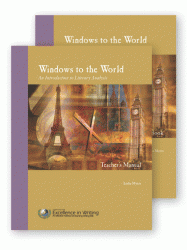Skill in literary analysis, formerly a core component of high school education, seems to be getting little attention as standardized testing makes other topics more important in most schools. Language arts still includes the study of literature, but many schools do little more than read and discuss works from a prescribed anthology. Lesha Myers has more ambitious goals in mind with Windows to the World: An Introduction to Literary Analysis. She wants to teach high school students “how to read, infer, analyze, and write about literature,” but she believes students need these skills to be able to recognize the power of literature to shape lives and worldviews. Consequently, this course requires students to reflect, research, and write much more than most. It is definitely written from a Christian perspective, both content and instructional material.
This is a challenging course, but perhaps not as overwhelming as it could be in the amount of content since Myers uses short stories and poetry rather than complete books. If students need additional work on concepts, the parent/teacher may assign additional short stories or novels for students to continue practicing techniques they have just learned. The amount of reading assigned can be varied to suit the student. Also, instruction is presented in manageable increments with examples and models so students know what is expected and how to complete each assignment. A very helpful Sample Schedule makes it easy to plan and present lessons.
Four main areas are covered: analytical techniques, literary elements, literary devices, and writing genres. Reading selections are not all from a Christian viewpoint. A variety of viewpoints are reflected, giving students the opportunity to develop discernment as they learn to analyze the worldview of each author. Students learn to analyze, but they also practice writing using the elements or devices emphasized in each lesson. Myers includes several checklists for students to use; these make it easier for students to recall elements they should identify.
One key strategy Myers teaches is annotation, that is, writing notes and comments in the margins and between lines as the student reads. This strategy is the basis of most other literary analysis taught in this course. In Windows to the World, lessons on spotting and interpreting allusions teach skills not always included in other such courses, especially not biblical allusions. Yet Myers spends an entire lesson on them and includes some assignments for both analyzing and creating allusions. On a personal note, I was just reading a novel where the author, a non-Christian, alluded to camels and the eyes of needles to indirectly highlight the difficulty faced by a wealthy character in the story. Myers points out that biblical illiteracy makes most such allusions meaningless to a large percentage of modern readers.
The course components are a student book and a teacher’s manual. The student book is written directly to the student and allows the student to do much work independently. The teacher’s manual presents fairly detailed lesson plans for a semester course, although it might be condensed or expanded. The Student Book contains the short stories and poems to be read and analyzed, and it also serves as a workbook; students complete written exercises within the book and they also make annotations directly in the book as they read the various works. Other suggested reading material is available on the internet.
While it is possible to use this course with a single student, it will likely work much better with two or more students. Most instructions are written with the assumption that there is a group class with quite a bit of work in small groups.
Even though the reading assignments are not lengthy, this is still a challenging course. The level of vocabulary and thought required is demanding. Teachers will need to spend time in preparation and planning so they are familiar with the material before attempting to lead discussions. However, it should be well worth the time and effort invested since I expect that both the teacher and the students will learn a great deal through this course.










